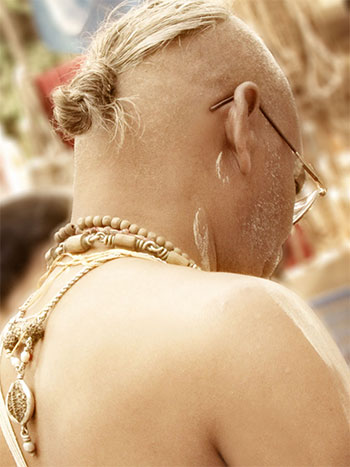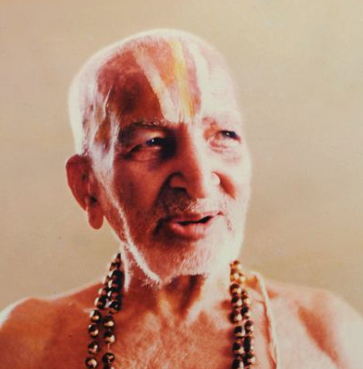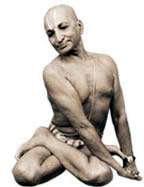P.J.
0
Why Do Hindus Wear the Tuft of Hair Called Shikha

Shikha is a tuft of hair at the back of head specifically kept by Vaishnavas and Brahmanas. According to the Vedic culture, when a person undergoes the cuda-karana-samskara (hair-cutting ceremony) and upanayana (Vedic initiation), he must shave his head, leaving a tuft of hair called a sikha.
It is an established rule that anyone who recites Vedic mantras should not have hair on face and head. So, those who need to perform Vedic rituals are advised to remove their hair.
Our human body has seven energy centres, or chakras, starting from the first at the base of the spine (Mooladhara Chakra) to the seventh and last one – the Sahasrara Chakra. The kundalini is the snake like subtle energy lying coiled at the base chakra, which through yogic exercise can be made to uncoil and rise up through the chakras, finally to the top one, the Sahasrara. The master, one who has achieved the final goal, or enlightenment or perfection or union, is one wherein the kundalini would have reached the Sahasrara chakra.
A Brahmin is one who after all his interim intellectual pursuits, is in ultimate search of this final union or state of perfection. At this point he is said to be one with the Brahman. This is the brahmin’s final goal.
The shika covers that part of the skull wherein lies the final chakra – the Shasrara Chakra. He retains the hair to protect it. Then the question would arise, why shave of the rest of his head?
One of the main rituals of the brahmin’s practice is the Surya Vandana, and Sandya Vandana. It is believed that the sun is the primary source of clean energy not just to the physique, but also to the mind. He wants the uninterrupted rays of the sun to fall on his brain and soak in. (Remember, hair, like our nails, is dead matter.) He stands in the sun three times a day to pray, chant his mantras and meditate – facing the sun.
However, there are many reasons for having Shikha:
1.) When a devotee leaves his body Krishna pulls the soul from the top most chakra which is on the head under the shikha.
2.) It is said that according to the karma of a soul, the living entity at the time of death leaves the body from different places, from mouth, nose, etc… But a devotee who leaves this body from that chakra (sahasrara at the shikha) attains high planets of the Spiritual world.
3.) Also hair is needed to protect that chakra. Women do not cut their hair, because their other lower chakras are not protected well, but if they have long hair they protect them with their hair.
4.) The mayavadis follow the ascending path since they egotistically confident of achieve God and coming out of illusion by the dint of their insignificant efforts or sadhana. So they do not keep a shikha because they do not need the mercy of the Lord.
5.) Shikha is also like a spiritual antenna on the top of the head meant to show to the Lord and that we are aspiring recipients of His causeless mercy.
6.) One must have a sikha to perform any kind of yajna. Therefore in Indian tradition all the brahmanas, Vaisnava or otherwise, keep a sikha. Although there seem to be no sastric injunctions regarding the size of the sikha, Gaudiya Vaisnavas traditionally keep the sikha about the size of a calf’s hoofprint, approximately 1.5 inches (5 – 6 cm.) in diameter.
7.) Srila Prabhupada mentioned this in a conversation with some of his disciples in Hawaii (6.5.1972): “Gaudiya Vaishnava shikha is an inch and a half across — no bigger. Bigger shikha means another sampradaya…. And they have to be knotted.”
8.) The shikha may be any length, but it should be kept tightly knotted and only untied when you are washing, The Hari Bhakti Vilasa observes that members of the upper classes even tie the sikha before taking the final ablutions of a bath. This particularly applies when bathing in a body of water such as a river or a lake, in which case to not tie the shikha prior to bathing is considered low class and disrespectful to the sacred rite of bathing.
You may tie it in a simple manner for bathing, retying it more carefully after the bath. Also, when going to sleep, attending funeral rites, or observing a period of mourning, you should keep the shikha untied. Since an untied shikha is a sign of a death in the family, it is inauspicious to go about one’s daily duties with an untied shikha. It is also said that if one keeps the shikha untied, the body may become weak.
While tying your sikha after bathing, chant the Hare Krishna mantra, or, if initiated with Gayatri mantras, silently chant the Brahma-gayatri (first line of Gayatri). The shikha should not be braided (traditionally only women braid their hair), nor should it be kept long and disheveled. Naturally, if the shikha is too short to be tied, it is all right to leave it open, but it should not be disheveled.
9.) Significance of Shaving head – It is a symbol of renunciation. If you see materialists, they are extremely fond of hair. Decorating hair etc pulls us into bodily consciousness. This is not good for practicing spiritualists. So as an indication of renunciation from material consciousness devotees shave head.
10.) Significance of shikha – Another view: It is a symbol of duality of souls and supreme Lord. Impersonalists believe that there is no duality between the supreme and the living entity and they are expected to shave their heads completely. Vaishnavites believe in the philosophy that there is clear and eternal distinction between supreme god Krishna and living entities. The shikha is symbol of Krishna which is large and the remaining very little hair is the symbol of insignificant and innumerable conditioned living entity
11.) Scientific Reasons for Having a Shikha:
(A) A person who keeps Shikha attracts cosmic energy which imparts enlightment.
(B) The small portion of hair that hangs from behind our head applies little pressure on our brains that helps one to improve concentration and mind control and improve memory.
From the time of the Vedas, the shikha was a distinguishing feature of the Brahmins, Kshatriyas and Vaishyas. It signified the ‘twice-born’ or all those Upanayanam has been performed. At the time of Chudakarana, a tuft of hair was left on the head, never to be cut. This shikha covered a large part of the brain. According to Sushruta, the reason that a few tufts are left on the head is that at the crown, an artery joins a critical nerve juncture. Since an injury to this part of the head is believed to be fatal, it was considered necessary to protect the area by keeping a tuft of hair over it. The shikha was a symbol of superiority and of cleanliness.
Any religious or auspicious ceremony required the shikha to be tied in a knot. The knot was tied to the accompaniment of the Gayatri Mantra. An untied shikha was a symbol of disgrace, impurity and mourning.
Why Do Hindus Wear the Tuft of Hair Called Shikha

Shikha is a tuft of hair at the back of head specifically kept by Vaishnavas and Brahmanas. According to the Vedic culture, when a person undergoes the cuda-karana-samskara (hair-cutting ceremony) and upanayana (Vedic initiation), he must shave his head, leaving a tuft of hair called a sikha.
It is an established rule that anyone who recites Vedic mantras should not have hair on face and head. So, those who need to perform Vedic rituals are advised to remove their hair.
Our human body has seven energy centres, or chakras, starting from the first at the base of the spine (Mooladhara Chakra) to the seventh and last one – the Sahasrara Chakra. The kundalini is the snake like subtle energy lying coiled at the base chakra, which through yogic exercise can be made to uncoil and rise up through the chakras, finally to the top one, the Sahasrara. The master, one who has achieved the final goal, or enlightenment or perfection or union, is one wherein the kundalini would have reached the Sahasrara chakra.
A Brahmin is one who after all his interim intellectual pursuits, is in ultimate search of this final union or state of perfection. At this point he is said to be one with the Brahman. This is the brahmin’s final goal.
The shika covers that part of the skull wherein lies the final chakra – the Shasrara Chakra. He retains the hair to protect it. Then the question would arise, why shave of the rest of his head?
One of the main rituals of the brahmin’s practice is the Surya Vandana, and Sandya Vandana. It is believed that the sun is the primary source of clean energy not just to the physique, but also to the mind. He wants the uninterrupted rays of the sun to fall on his brain and soak in. (Remember, hair, like our nails, is dead matter.) He stands in the sun three times a day to pray, chant his mantras and meditate – facing the sun.
However, there are many reasons for having Shikha:
1.) When a devotee leaves his body Krishna pulls the soul from the top most chakra which is on the head under the shikha.
2.) It is said that according to the karma of a soul, the living entity at the time of death leaves the body from different places, from mouth, nose, etc… But a devotee who leaves this body from that chakra (sahasrara at the shikha) attains high planets of the Spiritual world.
3.) Also hair is needed to protect that chakra. Women do not cut their hair, because their other lower chakras are not protected well, but if they have long hair they protect them with their hair.
4.) The mayavadis follow the ascending path since they egotistically confident of achieve God and coming out of illusion by the dint of their insignificant efforts or sadhana. So they do not keep a shikha because they do not need the mercy of the Lord.
5.) Shikha is also like a spiritual antenna on the top of the head meant to show to the Lord and that we are aspiring recipients of His causeless mercy.
6.) One must have a sikha to perform any kind of yajna. Therefore in Indian tradition all the brahmanas, Vaisnava or otherwise, keep a sikha. Although there seem to be no sastric injunctions regarding the size of the sikha, Gaudiya Vaisnavas traditionally keep the sikha about the size of a calf’s hoofprint, approximately 1.5 inches (5 – 6 cm.) in diameter.
7.) Srila Prabhupada mentioned this in a conversation with some of his disciples in Hawaii (6.5.1972): “Gaudiya Vaishnava shikha is an inch and a half across — no bigger. Bigger shikha means another sampradaya…. And they have to be knotted.”
8.) The shikha may be any length, but it should be kept tightly knotted and only untied when you are washing, The Hari Bhakti Vilasa observes that members of the upper classes even tie the sikha before taking the final ablutions of a bath. This particularly applies when bathing in a body of water such as a river or a lake, in which case to not tie the shikha prior to bathing is considered low class and disrespectful to the sacred rite of bathing.
You may tie it in a simple manner for bathing, retying it more carefully after the bath. Also, when going to sleep, attending funeral rites, or observing a period of mourning, you should keep the shikha untied. Since an untied shikha is a sign of a death in the family, it is inauspicious to go about one’s daily duties with an untied shikha. It is also said that if one keeps the shikha untied, the body may become weak.
While tying your sikha after bathing, chant the Hare Krishna mantra, or, if initiated with Gayatri mantras, silently chant the Brahma-gayatri (first line of Gayatri). The shikha should not be braided (traditionally only women braid their hair), nor should it be kept long and disheveled. Naturally, if the shikha is too short to be tied, it is all right to leave it open, but it should not be disheveled.
9.) Significance of Shaving head – It is a symbol of renunciation. If you see materialists, they are extremely fond of hair. Decorating hair etc pulls us into bodily consciousness. This is not good for practicing spiritualists. So as an indication of renunciation from material consciousness devotees shave head.
10.) Significance of shikha – Another view: It is a symbol of duality of souls and supreme Lord. Impersonalists believe that there is no duality between the supreme and the living entity and they are expected to shave their heads completely. Vaishnavites believe in the philosophy that there is clear and eternal distinction between supreme god Krishna and living entities. The shikha is symbol of Krishna which is large and the remaining very little hair is the symbol of insignificant and innumerable conditioned living entity
11.) Scientific Reasons for Having a Shikha:
(A) A person who keeps Shikha attracts cosmic energy which imparts enlightment.
(B) The small portion of hair that hangs from behind our head applies little pressure on our brains that helps one to improve concentration and mind control and improve memory.
From the time of the Vedas, the shikha was a distinguishing feature of the Brahmins, Kshatriyas and Vaishyas. It signified the ‘twice-born’ or all those Upanayanam has been performed. At the time of Chudakarana, a tuft of hair was left on the head, never to be cut. This shikha covered a large part of the brain. According to Sushruta, the reason that a few tufts are left on the head is that at the crown, an artery joins a critical nerve juncture. Since an injury to this part of the head is believed to be fatal, it was considered necessary to protect the area by keeping a tuft of hair over it. The shikha was a symbol of superiority and of cleanliness.
Any religious or auspicious ceremony required the shikha to be tied in a knot. The knot was tied to the accompaniment of the Gayatri Mantra. An untied shikha was a symbol of disgrace, impurity and mourning.
Why Do Hindus Wear the Tuft of Hair Called Shikha




